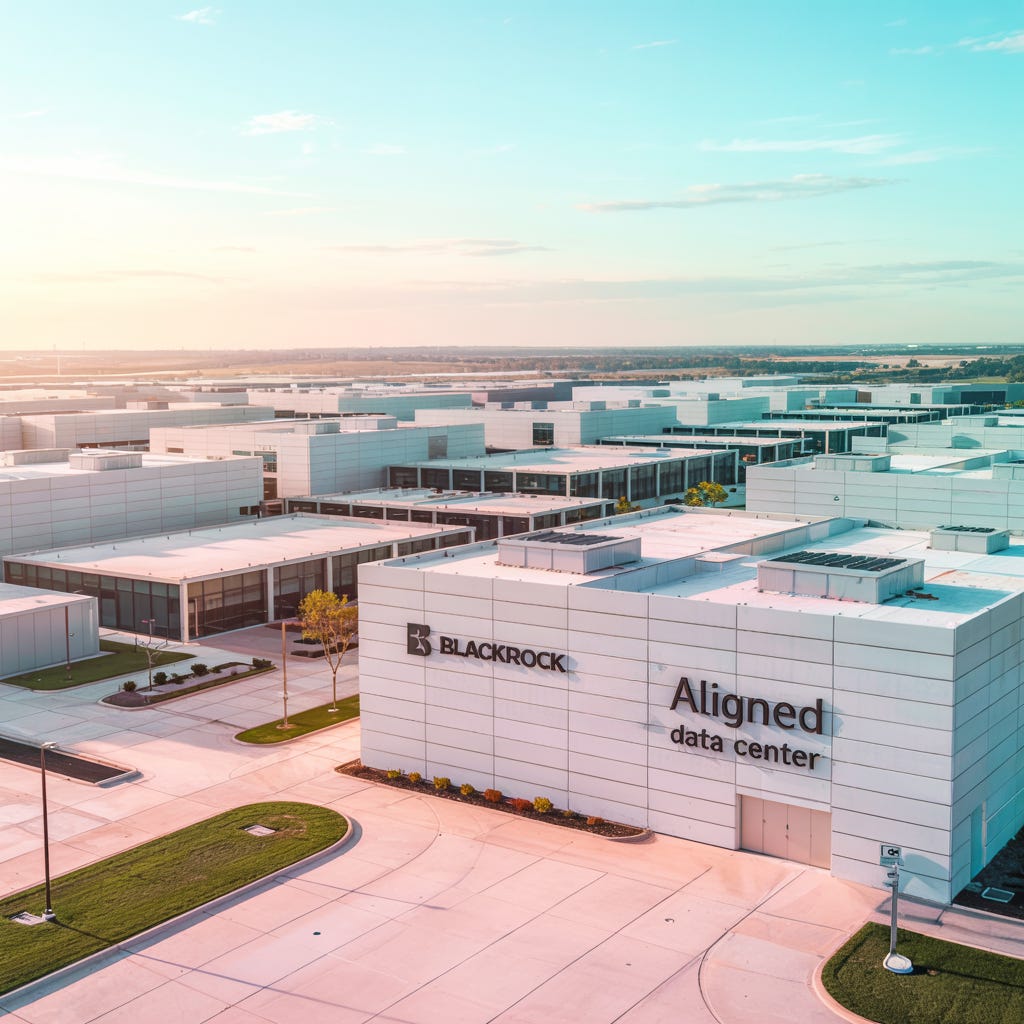Can BlackRock’s $40 B Aligned Deal Make “Time-to-Power” the New Market Multiple?
Inside the record-breaking acquisition that redefines how investors, operators, and sovereigns value AI infrastructure not by earnings, but by how fast power can go live.
Welcome to Global Data Center Hub. Join investors, operators, and innovators reading to stay ahead of the latest trends in the data center sector in developed and emerging markets globally.
Beyond the Headline
When BlackRock’s Global Infrastructure Partners, Abu Dhabi’s MGX, Microsoft, Nvidia, and xAI announced a $40 billion takeover of Aligned Data Centers in mid-October 2025, the headline sounded familiar: another big digital-infrastructure deal.
Look closer and the math tells a different story. At roughly $8 million per megawatt across 5 gigawatts of capacity, the market just priced time itself the months shaved off waiting for transformers, permits, and interconnects. The new metric: time-to-power.
From power constraint to capital premium
A year ago, valuation tables still started with EV/EBITDA. Today, boards begin with “Where is it energized?” and “Who controls the queue?” The shift is structural.
Data-center expansion once depended on construction schedules and tenant demand. Now it depends on substation rights, HV switchgear, and access to firm power. If a site can go live a quarter earlier, its megawatts earn a valuation premium.
Aligned’s pipeline checked those boxes: entitled land, procured equipment, and flexible cooling that can handle GPU densities beyond 300 kW per rack. The buyers paid for certainty in an industry where delay is the costliest risk.
The consortium’s logic
The AI Infrastructure Partnership (AIP) combines three forces rarely aligned on one cap table:
Institutional capital (BlackRock / GIP) bringing long-duration funding and infra discipline.
Sovereign capital (MGX, Temasek, Kuwait Investment Authority) linking national AI strategy to real assets.
Technology tenants (Microsoft, Nvidia, xAI) securing their own compute supply instead of renting it.
AIP plans to deploy $30 billion of equity with debt capacity toward $100 billion. That scale turns it into a de facto AI utility an entity built to control power, capacity, and supply chains at once.
What aligned actually brings
Aligned grew from two facilities in 2018 to roughly 50 today across the U.S. and Latin America under Macquarie’s ownership, using a standardized “expand-on-demand” design model.
Its latest generation features Delta³ and DeltaFlow cooling systems, which switch between air and liquid without disruption a capability crucial as AI loads exceed air-cooling limits.
The platform is a ready-made scaling machine, with a 5 GW pipeline under development, sustainability-linked financing, and a management team experienced with hyperscale tenants.
Why macquarie exited at the top
Macquarie bought Aligned in 2018 at around 85 MW and scaled it to 5 GW within seven years. The $40 billion sale delivers one of its largest private-equity exits, reflecting the company’s rapid expansion and operational strength.
The transaction also frees capital for new HPC joint ventures, showing that Macquarie is rotating from mature platforms into greenfield AI projects closer to generation assets.
Valuation reset: the new multiple
The Aligned deal sets a new benchmark in digital infrastructure. In 2025, the $40 billion acquisition valued the company at roughly $8 million per megawatt, reflecting a premium for speed and certainty in power delivery.
By comparison, AirTrunk in 2024, CyrusOne in 2021, and Switch in 2022 were priced between $3 million and $4 million per megawatt, highlighting how control over energized capacity has become a key driver of value.
Investors are increasingly rewarding grid-connected capacity and energy redundancy, not just revenue. The market now prices the option value of entitlements and transformer orders, emphasizing the strategic advantage of faster deployment.
Who benefits and who adapts
Investors will re-rate portfolios based on megawatt availability and delivery speed, not pure yield.
Operators will need in-house power teams and OEM relationships to compete with vertically integrated consortia.
Policy makers face new questions about foreign ownership of critical digital capacity and grid allocation.
CFIUS review will scrutinize the foreign stake in U.S. critical infrastructure, but blocking is unlikely. Expect conditions around data handling and non-discriminatory access.
Where the capital flows next
The smart money is moving one layer upstream toward grid modernization, HV equipment manufacturing, and renewable firming assets that feed AI loads. Each component of the supply chain that shortens “time-to-power” gains valuation leverage.
Watch for:
new fund mandates targeting transmission and substation projects
equipment manufacturers signing forward supply agreements with hyperscalers
hybrid PPA structures tied to AI data center uptime metrics
Why this deal matters
The Aligned sale isn’t just a record. It represents a re-pricing of how markets value energy access in the digital supply chain. Owning MWs that can go live faster than competitors is now a clear financial edge.
For AI builders, that speed directly accelerates model iterations and revenue. For investors, it translates into multiples the market has rarely seen before.
“Time-to-power” is no longer just a project metric. It has become the multiple that moves markets.
The Bottom Line
Time-to-power is the new currency in digital infrastructure. Deals are no longer just about land, tenants, or revenue they’re about who can energize first. Investors are pricing certainty, speed, and grid access, not just EBITDA.
Operators and policy makers must adapt to a world where energy access drives valuation. Aligned’s $40B exit signals that speed wins, and every month shaved off delays now carries a multi-million-dollar premium per megawatt.

